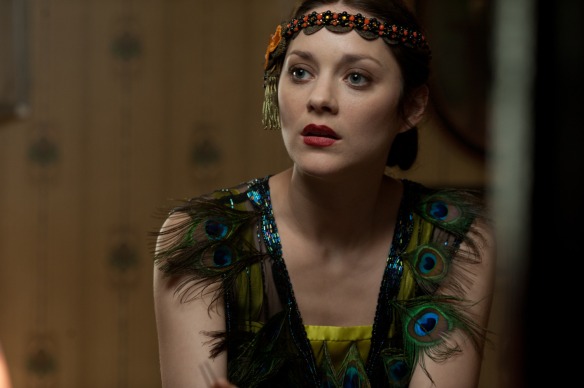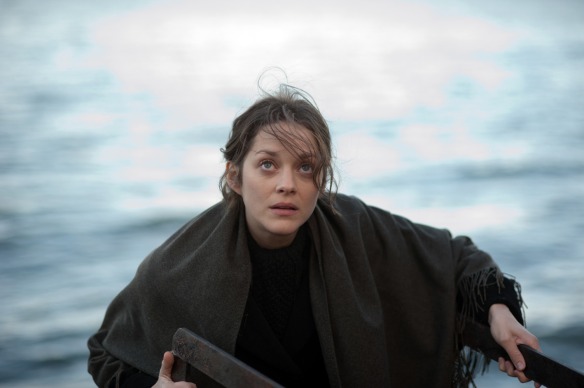In Brief: A melodrama that tries to throw back to Hollywood’s Golden Era but really just needs to be thrown back **
source: Theatrical showing
It’s difficult for me to imagine who on Earth actually wants to make films like this but then I read up on the writer/director’s influences and it all becomes clear. Apparently this project was written with two things specifically in mind: firstly that Marion Cotillard’s visage communicates realms of depth akin to Falconetti’s famous performance in The Passion of Joan of Arc and secondly, where did those great roles for the likes of Barbara Stanwyck and Bette Davis go?
With those elements in place, James Gray set to work to design a film that is, ostensibly, just a horrible misunderstanding of how good film works. After all, taking nothing from Falconetti’s miraculous presence, there was a whole lot more going on in the film than her just staring at the camera looking distressed. Meanwhile, while I’ve also found myself wondering where things went so wrong for women in Hollywood, where in the liberated 2000s they now have noticeably less purchase than they did in the patriarchal snare of the 1950s, I’ve never thought the solution was to try and recreate those old performances verbatim.
Gray’s film then, is some kind of attempt at a throwback melodrama, a film of the fifties reborn anew. Alas, there’s something missing here, and that’s the originality and creative zeal of those original productions. Cotillard and those who surround her are capable actors but, almost from the very first frame, this film feels like a spoof, gathering every conceivable cliché about immigrants gathering at Ellis Island, trying to gain their entry into the New World and the American Dream, and tossing them about with grand abandon. Cotillard’s visage, her make-up made-down, does indeed remain radiant as she plays a put-upon Polish woman trying to bring her sickly sister through. And yes, Cotillard’s character is demure but possesses an intractable inner strength and yes, her sister has Tuberculosis/lung disease because that’s a rule. To reinforce her credibility in the role, Cotillard speaks lots of Polish because that requires extra work of the actor and proves their dedication to their craft. Of course what this all really adds up to is a cinematic purgatory where nothing feels authentic and there’s no conviction in the film’s clear artifice either. Back in the fifties, the lead actress would have arrived to the island in full glamour make-up and she would have spoken perfect English with shimmering close-ups, allowing perhaps a clumsy hint of a non-specific ‘foreign’ accent for dramatic effect. And that would be fine, because it’s a movie. The Immigrant‘s unfortunate recipe of modern sheen and wholesale theft of every trope of ‘the immigrant experience’ (Disney World take note, this could be the new Pirates of the Caribbean) seems to fatally misconstrue what made Stanwyck and Davis stars.
It doesn’t help that the story itself is one of almost cripplingly little interest. A woman shows up, she is abused, she remains strong as women do, men do stupid stuff around her, she forgives them, there’s a murder etc. Again it’s not so much that the tale is so classic that its repetition is merited but rather that we’re trudging through the foot-prints of a thousand better works of art. Meanwhile where Gray feels like making a social point, like how Joaquin Phoenix’s character, an exploitative Jewish pimp, is himself an outsider in larger American society, he helpfully labours this point by having the police constantly call him a ‘kike’ before beating him up. This happens more than once. Thanks Mr. Director, glad I didn’t miss that little nugget of, ‘hmmm, makes ya think.’
Meanwhile the film’s visuals, shot by the eminently talented Iranian cinematographer Darius Khondji, are steeped in a horrible yellow that I have noticed creeping more and more into contemporary cinema. His compositions are elegant and, to the most part, suitably traditional, but this awful colour-balance, perhaps an attempt to hint at sepia, renders the entire film utterly unappealing to my eye. Previous generations could look back fondly on the ravishing ‘inaccuracies’ of Technicolor and how they were harnessed by the masters of the trade (Jack Cardiff for example, a magician) but I cannot fathom anyone ever looking back at this kind of tampering and wishing it were employed more often. At best it’s vaguely irritating, at worst it sets me on the path of designing jokes about the film stock perhaps being developed in a bucket of piss. And no one wants that to happen.
The main saving grace was catching the film with an audience in which I was among the youngest member. I’ll say this, whatever disparaging remarks I might conjure up, the film seemed a pretty solid hit with ladies in the 70+ year-old bracket who surrounded me and gasped and smacked at every lumbering twist of the plot. Which seems a fair summation of the film. If you’re an easily impressed, elderly woman, then you could apparently do worse than watching this. As for me, I’d take Chaplin’s film of the same title any day. It’s funnier, sadder, considerably shorter, and it’s cinematographically urine-free too. And to top it all off, it was made five years before this film was even set. Which means that even harking back to the past, James Gray still managed to be behind the curve.



